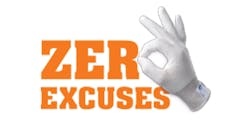Safety 2014: Zero Excuses for Workplace Hand Injuries
Hand injuries – like the vast majority of workplace injuries – are preventable. Still, year after year, hand injuries are among the leading causes of missed workdays and emergency-room visits, costing employers millions of dollars in workers’ compensation costs and lost productivity.
That’s why DSM Dyneema and EHS Today launched the “Zero Excuses” campaign in October 2012. Appropriately, “zero excuses” was the theme of a Dyneema/EHS Today luncheon at the American Society of Safety Engineers’ 2014 Professional Development Conference and Expo in Orlando, Fla.
“Zero excuses is more than just a clever phrase,” said keynote speaker David Lynn, CSP, vice president of signature services for Greenville, S.C.-based Life and Safety Consultants Inc. “Zero excuses means that you accept the fact that you’re accountable [for hand safety] and that you control it.”
Lynn, a former OSHA compliance officer and corporate EHS manager, explained that the elements for building a workplace hand safety program include trend analysis, hazard assessment, training, communication, planning, compliance and follow-through.
“There’s no rocket science to it,” Lynn said. “It’s really doing what you would do as part of any improvement process.”
A hand safety program begins with tracking hand injuries and analyzing the data for trends. It’s not just about analyzing the types of hand injuries that are occurring, Lynn explained. It’s also important to know what types of job tasks workers are involved in when they hurt their hands.
For example, in his consulting work with one company, Lynn’s analysis revealed that many hand injuries were occurring while workers operated tools and equipment.
“So we were able to extrapolate the trends out of those injuries and begin to see where the issues were,” he explained.
The results of the trend analysis and hazard assessment will help determine the types of engineering and administrative controls and PPE needed to protect workers’ hands. Lynn advised including the hand-protection supplier and other stakeholders in the process.
“It’s good to get input not only from the vendor or the company with the technology [such as Dyneema] but also from the user,” Lynn explained. “Because they know what they’re using, how they’re using it and where they’re most likely to get injured.”
Training the workforce on the guidelines of the hand-protection program – and why the guidelines are needed – is important, of course. But following up and reiterating the message is doubly important, Lynn asserted.
“Going out there and reminding people of what you said, in a coaching setting, probably has the biggest impact,” Lynn explained.
For more information on hand safety, visit the Zero Excuses website.
Lynn emphasized the importance of reiterating the requirements of the hand safety program through a formal communication campaign as well. In addition to verbal reminders, the campaign should incorporate written communication – such as posters, fliers and banners – to make it “visual and visible.”
Lynn used the term “campaign” intentionally.
“You have to hear the message from all angles, just like we’re bombarded by commercials during election season,” Lynn said. “That’s what zero excuses means from a communication perspective.”
Not to be overlooked is the compliance and follow-through element. Communication and training are all well and good, but “no excuses means you need people to comply,” Lynn said.
Among the methods for monitoring workers’ compliance are safety alerts, checklists and focused audits. In his experience, Lynn said the focused safety audit is one of his favorite monitoring methods.
As a former EHS manager at Fluor Corp., Lynn recalled a project that was beleaguered by “a rash of hand injuries.” The company tried a number of approaches to raise awareness of hand safety, “but what really made the difference was when we started doing focused audits.”
He noted that the audits were structured as coaching sessions, not punitive actions.
“It’s not that people want to hurt their hands,” Lynn said. “It’s just that people need some encouragement at the right times when they’re at the most risk.”
